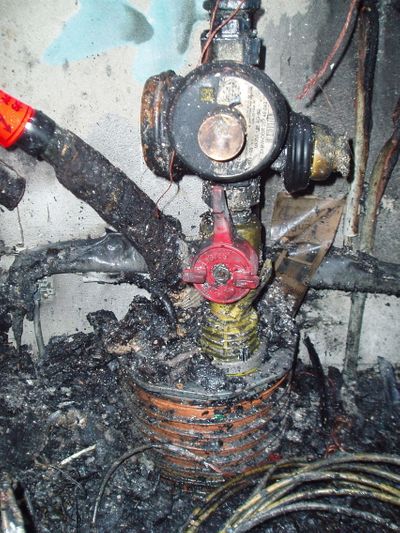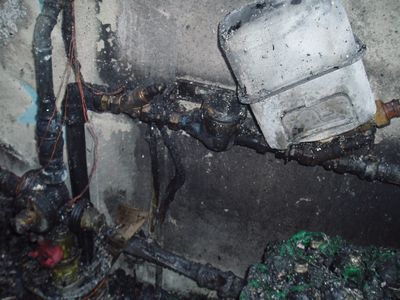
SCHUCK Firesafe FI - The Clever Switch Lever
Gas house entries with integrated main shut-off valves must meet a high standard to receive approval in Germany, Austria and Switzerland.
In addition, the Schuck Firesafe FI switching lever provides extended protection for the gas installation and the entire building, comparable to a thermally triggered shut-off unit (TAE). A security feature that should not be underestimated. Here, too, safety is the top priority for Schuck.
The SCHUCK Firesafe switch lever, for example, creates an extremely high safety standard for the HSP gas house lead-in and other SCHUCK fittings.
We spoke to the responsible product manager Robert Barthle about this.
You can also find out how the safe gas house entry from SCHUCK works and how it proves itself in an emergency, i.e. in the event of a building fire the Schuck Fire Safe lever closes the valve automatically at a temperature of 90 °C.
What are the requirements for fire-safe building entries?
In addition to many requirements, e.g. for the materials used , there are also requirements that cannot be met by the building entry itself, but only in combination with an approved installation material and method.
Particularly noteworthy here are the requirements for a tight and stable connection between the building entry and the building. For this we recommend the use of our tried and tested range of accessories, in particular our Schuck-Beto-Fix Plus , the sealing flange 18533 and the LRS for buildings without a basement .
In addition to these obvious requirements, there is another, no less important requirement for the fire safety of a gas house lead-in. According to this, a gas house entry must retain its internal and external tightness even if it is exposed to a fire, e.g. if a fire breaks out in a house connection room. Due to the potential risk of uncontrolled gas leakage in such a case, this requirement is particularly important for a safe gas supply.
What is the difference between internal and external tightness?
The inner tightness relates to the tightness of the main shut-off in the direction of the installation line, the outer tightness relates to a gas leak from the line into the room. In addition, the fire resistance of the installation material is also decisive since a test pressure is also applied here during the test and the leakage is assessed.
How does the test for safe gas house entry work?
The approval test provides for a simulated fire to which a house entry is exposed. For this purpose, a house entry is built into a special furnace. The fire temperature is reached during 15 minutes of heating and then held for 30 minutes. The leakage is measured over the entire time and must not exceed a specified limit value so that the test can be assessed as positive.
Schuck HSP building entries exceed these requirements by clearly falling below the limit values and by the fact that they can withstand extended test times without any problems.

How Does the Clever FI Firesafe Switch Lever Work?
Since the main shut-off valve is usually in the open position and manual closing of the valve can be dangerous or impossible in the event of a fire, a particularly clever solution is required here:
A switch lever that automatically detects a fire and then automatically closes the ball valve.
Our Schuck Firesafe gear lever FI fulfils exactly this task. Due to the special design of the switching lever, it detects a fire based on the temperature and then reliably closes the main shut-off device of the HSP building entry. The gas flow into the building is interrupted, thus guaranteeing a high level of safety.
SCHUCK Firesafe Gear Lever for Gas House Entry in Action
If the temperature reaches a certain value, the fitting detects a fire and automatically shuts off the gas supply. This function can be clearly heard at 0:30 minutes in the video.
So Much for The Theory - But Can You Rely on The SCHUCK Firesafe FI Lever In An Emergency?
The case, which fortunately occurs rarely and against which many precautions are taken, occurred in January 2009. A fire on a company premises. A fire broke out in a factory on the Swabian Alb, literally ate its way through the entire company property and destroyed, among other things, the entire lower half of the building including the basement of an administration building.
The gas connection with Schuck HSP gas house entry was located in this - protected by a Schuck Firesafe FI switch lever . This locked the main shut-off device as intended and the building entry withstood the fire until the fire brigade had the fire under control. Up until this day, the introduction of the house in the basement was a silent companion and a guarantee of security in the event of an emergency.
Without them there might have been a real disaster that evening. The fire would have melted the installation and the escaping gas would have exploded. The devastating effect of such a gas explosion is well known.
The picture shows the house connection after the fire. It is very easy to see that the inner part of the Firesafe switching lever has been turned by 90 ° and has thus closed the ball valve in accordance with the standard.
- In this way, greater damage could be averted.
- More proof is not possible.



Read everything about the product SCHUCK HSP gas house lead-in here
Tip: The Schuck Firesafe lever is not only available for HSP gas house lead-ins, but also provides more safety for other Schuck products, such as the Sanova renovation capsule and many Schuck ball valves. It can also be retrofitted by simply replacing the previous shift lever.
Download & Bonus material:
--> Watch the YouTube video on the SCHUCK Firesafe "FI" Switch Lever.


